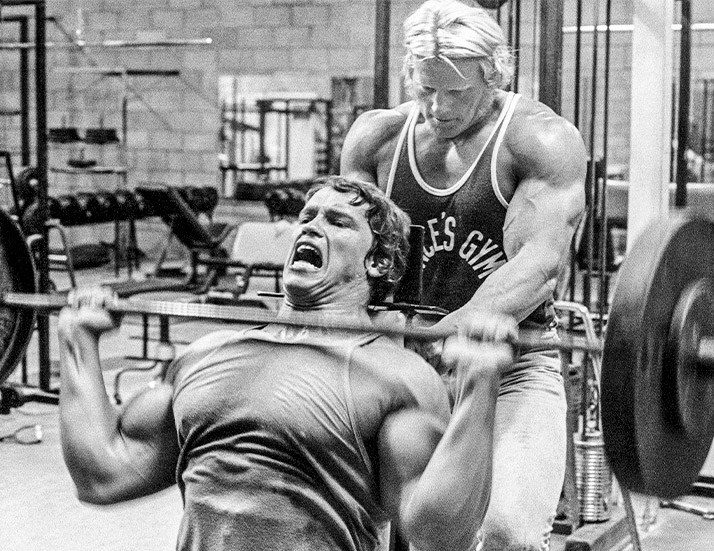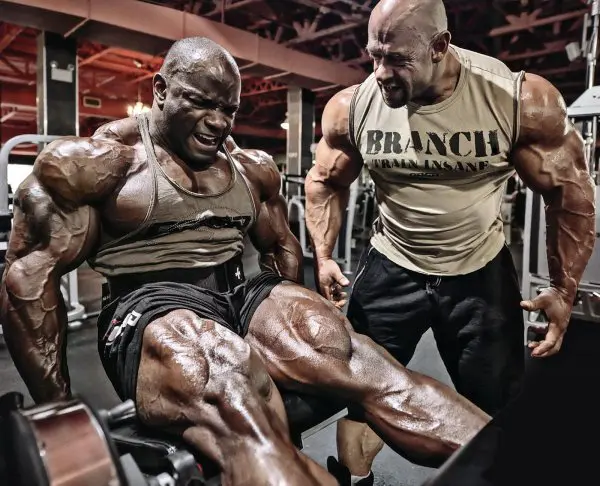Should you train to failure, or is it best to leave a couple of reps in the tank? We explore this hotly debated bodybuilding topic.
When it comes to building strength and muscle, intensity matters. That means hard workouts generally produce better results. That’s because your body is actually pretty lazy and would prefer not to waste energy on building muscle. Therefore, there needs to be a significant stimulus to make it trigger hypertrophy.
But how intense do your workouts need to be to be effective? Opinions vary.
On the one hand, fans of very high-intensity strength training say you need to push your muscles to failure or beyond to maximize hypertrophy. They believe that reps left in reserve (RIR) are wasted opportunities for growth.
On the other hand, more conservative approaches suggest that training to failure is unnecessarily demanding, and you can get the same results from less intense workouts, stopping several reps shy of failure.
Who’s right? Actually, there is evidence to support both points of view. And, as with many training topics, you’ll need to determine the approach that is right for you.
Level Up Your Fitness: Join our 💪 strong community in Fitness Volt Newsletter. Get daily inspiration, expert-backed workouts, nutrition tips, the latest in strength sports, and the support you need to reach your goals. Subscribe for free!
In this article, we explore when, why, and how to train to failure so you can decide if this is something you need to do for your gains and goals.
But first, let’s make sure we’re all on the same page by defining what training to failure actually is.
What is Training to Failure?
One of the reasons that training to failure is such a controversial topic is that there are various interpretations of what failure is. Even studies on training to failure have different definitions, which doesn’t help make this topic any less confusing.
So, what does training to failure mean, and how do interpretations vary? Let’s take a look!
1. Form Failure
This is the definition of failure that most lifters are familiar with. Form failure means you cannot do any more reps without changing your technique, e.g., using your legs and back to lift the bar during biceps curls. This is probably the most accessible form of failure training for most people.
2. Concentric Failure
Concentric failure occurs when you can’t complete the lifting phase of an exercise. For example, you can’t fully extend your arms during bench presses or lock out your squat or deadlift. While some lifters push themselves to concentric failure, most do not, as it can be dangerous and leave you pinned under a heavy bar. Concentric failure training often requires a spotter.
3. Speed/Velocity Failure:
This is the type of failure often used in studies. It is best defined as the point at which your movement speed decreases by a certain percentage, usually around 20%. However, because most gym rats don’t have access to a velocimeter, this definition is of less practical use.
Importantly, just because your movement speed decreases doesn’t mean you can’t crank out a few more reps. We even have a name for these slower repetitions – grinders. Most people can grind out several slow-mo reps at the end of a set. Speed/velocity failure is not very useful for our purposes.
4. Eccentric Failure
Eccentric failure occurs when you can no longer control the lowering phase of the exercise. For example, after reaching concentric failure during a set of pull-ups, you use your legs to help you get your chin above the bar and then lower yourself down. When you can no longer control your descent, you have hit eccentric failure.
Eccentric failure happens after concentric failure because you are stronger eccentrically than you are concentrically. In other words, you can lower more weight than you can lift.
5. Isometric Failure
Isometric failure is the point where you can no longer hold a weight in a fixed position, e.g., the mid-point of a pull-up. This is the deepest level of failure you can reach, as it comes after concentric and eccentric failure. If you are so fatigued that you can no longer lift, lower, or hold a weight at the end of your set, it’s safe to say your muscles really are exhausted.
6. Metabolic Failure
Metabolic failure occurs when exercise by-products such as lactate accumulate to such a degree that you are forced to stop. For example, during a set of high-rep leg extensions, your quads might burn so much that the pain forces you to stop.
However, this level of failure is not determined by muscle strength. Instead, it’s your ability to tolerate pain and clear lactate from your muscles, both of which vary according to training, experience, motivation, and genetics.
So, simply “training to failure” is not as straightforward as many people think, and there are degrees of failure from mild to extreme. For clarity and convenience, in this article, failure means form and concentric failure. They are the most widely used definitions and the most straightforward to implement. Things like speed/velocity failure and isometric failure are not really practical for our purposes.
Now we’ve defined failure, let’s move on to why training to failure can be beneficial.
Benefits of Training to Failure
Training to failure invariably means pushing past the point at which you’d normally want to end your set. In short, it’s gonna hurt! So, you probably want to know whether the reward is worth the effort.

To that end, let’s take a look at the main benefits of training to failure:
1. Increased Muscle Activation
Muscles are made of muscle fibers, and those fibers are grouped into motor units. Each motor unit is innervated or controlled by a single motor nerve. Motor units are recruited sequentially from smallest to biggest.
The closer you get to failure, the more motor units you activate. Therefore, if you want to stimulate the maximum number of available muscle fibers, training to failure will help.
2. Enhanced Muscle Hypertrophy
Leading on from the point above, evidence suggests that training to failure may result in more significant muscle hypertrophy compared to non-failure training (1). This makes sense, given what we know about motor unit engagement. However, it’s also important to note that additional gains from failure are typically very small.
Training to failure may also increase the release of human growth hormone and IGF-1, raise metabolic stress, and accelerate protein synthesis, all of which can aid in muscle repair and growth.
3. Increased Strength Gains
Training to failure can be effective for increasing muscular strength. Strength is your ability to generate force. Hitting failure can help desensitize your Golgi tendon organs, which are mechano-tension sensors in your tendons and the safety cut-offs in your muscles that limit force production (2). In short, they shut your muscles down when tension gets too high. Reducing the sensitivity of these sensors means you’ll be able to generate more force.
4. More Accurately Estimate Reps in Reserve (RIR)
Many training programs tell you to leave 1-3 reps in reserve. This means you stop your set 1-3 reps before failure. While you may be able to estimate this point, you’ll be more accurate if you have experienced training to failure and have a target to work toward. For example, if you know you can do 14 pull-ups to failure, leaving 1-3 reps in reserve will be much easier.
5. Measuring Progress
Training to failure allows you to accurately measure your progress over time. If you can do more reps with the same weight before failing, it’s safe to say your body has made some adaptations and, therefore, you have made progress, and your workouts are effective.
6. Psychological Boost
Reaching failure provides a psychological reward for your hard work. Training to failure reinforces the belief that you’ve had a productive workout. After all, if you hit failure, you’ve worked about as hard as it is possible to do so and given your all.
7. Time-Efficient
You can train hard, or you can train long, but you can’t do both. The closer you train to failure, the fewer sets you’ll need to do to fatigue your muscles and trigger gains (3). In fact, in a workout system called High-Intensity Training, or HIT for short, you only do one set to failure per exercise, so you’ll be in and out of the gym in minutes.
As such, if you are short of time, training to failure could allow you to make good gains despite briefer or less frequent workouts.
While training to failure has its benefits, there are drawbacks, too. Keep reading to discover the downsides of training to failure.
Drawbacks of Training to Failure
Despite the myriad benefits, there are also several reasons to avoid or limit training to failure. These include:
1. Difficulty in Accurately Judging Failure
The most significant difficulty in training to failure is knowing if you’ve really reached it. Oftentimes, you’ll end a set because you’re tired, in pain, or have hit a predetermined number of reps. This may still be several reps from failure. Just because you think you’re done doesn’t mean you really are.
2. Increased Risk of Injury
Training to failure increases the risk of muscle strains, joint sprains, and other forms of acute bodybuilding injuries. This is especially true if you do not maintain proper form. For example, if you round your lower back to push out another deadlift or two, the resulting injury could be severe enough to need several weeks off training, undoing any benefits of hitting failure.
3. Increased Rest Between Sets
The closer you get to failure, the more fatigued your muscles will be, and the more rest between sets you’ll need before you are ready to go again. This may increase the duration of your workouts or reduce the number of sets you can do per session.
4. Longer Recovery Between Workouts
Training to failure takes a lot out of your body. Not just your muscles but your central nervous system, or CNS for short. The harder you push your muscles and CNS, the longer they will need to recover between workouts. This could affect training frequency.
5. Increased Need for a Spotter
Training to failure, especially on exercises like the bench press or squat, often requires a spotter for safety reasons. Your spotter needs to be strong and confident so they can help you when your muscles can no longer continue working. They may also need to motivate and encourage you to push past the pain barrier. Good spotters are not always easy to find.
6. Mental Fatigue
Constantly pushing yourself to the limit can be mentally draining, potentially leading to burnout or a lack of motivation to train. You may find yourself dreading your next workout because you know how painful and demanding it will be. Needless to say, lack of motivation may stop you from reaching failure, and you may even be tempted to skip workouts, which will impair your progress.
7. Increased Risk of Overtraining
The mental and physical demands of training to failure are cumulative. If you fail to pay enough attention to nutrition and recovery, it could lead to overtraining syndrome. This is characterized by decreased training performance, increased risk of injury, impaired immunity, and other health issues like sleep disturbances.
8. Potential for Imbalanced Workouts
Training to failure is generally not recommended for complex, multi-joint movements like Olympic lifts, where technique is crucial for safety and effectiveness. Doing deadlifts or bent-over rows to failure could also be dangerous, as form breakdown can put injurious stress on your lower back.
As such, you probably won’t be able to train to failure for all exercises. This could lead to some body parts getting more work than others, creating muscle imbalances that could affect your physique and athletic performance.
9. Synergist Muscles Will Fail Before Agonists
When you do compound exercises like bench presses or lat pulldowns, small assistance muscles called synergists usually fail before bigger agonists or prime movers. This means these secondary muscles will probably get a better workout than the muscle you are targeting. As such, you should pick your exercises carefully.
Level Up Your Fitness: Join our 💪 strong community in Fitness Volt Newsletter. Get daily inspiration, expert-backed workouts, nutrition tips, the latest in strength sports, and the support you need to reach your goals. Subscribe for free!
10. Gains Are Marginal at Best
Studies indicate that while training to failure may enhance strength and muscle gains, but any advantages over non-failure training are very small (4). So, the question is, are those marginal gains worth the extra effort, or does the cost outweigh the benefits? That’s a decision only you can make.
With these drawbacks in mind, let’s move on to how to train to failure safely and effectively.
How to Train to Failure Safely
Training to failure can be a powerful tool in your fitness arsenal, but it’s crucial to use it the right way. Here are some actionable tips to help you train to failure safely and effectively:
1. Don’t Train to Failure All the Time
As effective as training to failure can be, you can have too much of a good thing. Consistently training to failure can lead to overtraining and increase the risk of injury. Therefore, it’s generally best to use training to failure periodically rather than all the time. For example:
- Week 1 – 3-4 reps in reserve (RIR)
- Week 2 – 1-2 RIR
- Week 3 – failure
- Week 4 – 3-4 RIR, etc.
In addition, you don’t have to train to failure on every exercise and every set in your workout. For example, you may gain greater benefits by saving failure training for the last set of final exercise for each muscle group. This will make your workout productive while minimizing the drawbacks of training to failure.
2. Use a Spotter
While you don’t always need a spotter to train to failure, there are some exercises where it is essential, such as bench presses and the aptly named skull crushers. If failing mid-rep could cause injury, make sure you’ve got a spotter on hand to keep you safe.
3. Opt for Moderate to High Reps
Training to failure with heavy weights for low reps is a recipe for injury. It’s also not especially effective, particularly for hypertrophy. Instead, make sure you can do 8-10 reps before hitting failure, and feel free to do higher rep sets. Moderate to higher reps are generally better for building muscle and considerably safer.
4. Avoid Having a Rep Target
If you expect to fail after a certain number of reps, you probably will. However, you may end your set before actual failure and just because you’ve hit your target for that exercise. Avoid this by starting your set with an open mind and just do as many reps as possible.
5. Use Mostly Isolation Exercises
Training to failure generally works better on isolation exercises like bicep curls or leg extensions than on compound movements like deadlifts or squats. A lot can go wrong with big exercises, and nearing failure will invariably compromise your technique, increasing the risk of injury.
6. Prioritize Good Form
Form breakdown when training to failure is all but unavoidable. However, there is a big difference between using a little body English to complete your last 1-2 reps and cheating to such an extent that the exercise is no longer safe. The former is acceptable, but the latter is not.
7. Listen to your body
Be aware of your body’s signals. If you feel sharp pain or discomfort, it’s a sign to stop immediately. Also, there will be days when you can push harder than others. Don’t force yourself to train to failure if you’re not feeling up to it. If you are still fatigued from your last workout, taking it easy will be more beneficial than pushing your tired body through another intense session.
8. Prioritize Nutrition and Recovery
Training to failure takes even more out of your body than regular workouts. As such, you must pay even more attention to rest and recovery if you choose to train to failure. So, make sure you get a solid 7-9 hours of sleep per night, fuel up with a healthy, nutritious diet, and avoid doing too much physical activity. Give your body the time and resources it needs to recover from your workouts. If you don’t, you’ll just dig yourself into a rut.
Now that you know how to train to failure safely and effectively, the final question is, do you even need to work this hard? Check out the next section and find out!
Is Training to Failure Necessary?
So, you’re wondering if you really need to push your muscles to failure to see gains? The short answer is no, but let’s dive a bit deeper.
Training to failure has its merits and can lead to increased muscle activation and a psychological edge. However, despite what the go-hard or go-home crowd tells you, it’s not the Holy Grail of fitness.
Firstly, going all out every time you train can lead to short and long-term injuries. You’ll also need more rest between exercises and workouts, which could disrupt your training schedule. And let’s not forget that training to failure can affect you mentally; it can be a real grind. Plus, you’ll often need a spotter, and good ones are often hard to find.
On the flip side, the benefits are hard to ignore. You may experience faster muscle growth and increased strength gains. It’s also a solid way to measure your progress. However, these advantages are very small and (5), for some, the effort is not worth the result.
All that said, you can still make solid gains without constantly training to failure (5). In fact, just getting close to failure is enough to trigger muscle growth and strength improvements. It’s like running a marathon; you don’t have to sprint the whole way to reach the finish line. Sometimes, pacing yourself can be just as effective and a heck of a lot safer.
So, is training to failure necessary? Not strictly. It’s a tool in your fitness toolbox, but it’s not the only one. Ultimately, it’s up to you to weigh the pros and cons of training to failure and decide whether it’s right for you. Of course, this means you’re going to have to try it.
Hungry for more information about training to failure? Learn even more about this topic in our FAQ!
Training to Failure – FAQ
Still have burning questions about training to failure? Don’t sweat it—our FAQ section has got you covered!
1. What is “training to failure,” and does it differ from regular training?
Strength and bodybuilding training usually involves pushing your muscles somewhat hard but ending your set with a couple of reps left in the tank. These are known as reps in reserve, or RIR for short. RIR can vary but is typically 1-3 reps.
With training to failure, you push your set until you cannot complete any more reps, so RIR would be zero. Fans of training to failure consider these extra reps more productive than the rest of the set. This point of view is supported by research. However, additional gains are typically marginal.
2. Is training to failure suitable for beginners?
Training to failure should be considered an advanced workout method. It involves pushing your muscles to their limit and can result in exercise form breakdown. It’s also very uncomfortable and not without risks.
As such, beginners should avoid training to failure and leave at least a few reps in reserve at the end of each set. As training is still a novel experience, this should be intense enough to trigger strength and muscle gains.
3. Is training to failure safe?
Training to failure is slightly more dangerous than ending your set with a couple of reps in reserve. Pushing to failure increases the risk of muscle and joint injuries, mainly because your form will probably deteriorate. There is also a danger of getting stuck under a heavy weight, e.g., during bench presses.
But, provided you warm up thoroughly, use a spotter, and listen to your body, you should be able to train to failure relatively safely.
4. What are the signs that I’m overdoing training to failure?
Training to failure too often can lead to overtraining, which is where your workouts outpace your ability to recover. Signs and symptoms of overtraining include:
- Chronic fatigue
- Decreased immunity
- Decreased performance
- Depressed mood
- Disrupted sleep
- Frequent illness
- Increased injury risk
- Increased resting heart rate
- Irritability
- Loss of appetite
- Persistent muscle soreness
- Reduced training motivation
- Unexplained weight loss
If you experience several of these symptoms at the same time, you should reduce training duration and volume to allow your body to recover. Ease back into training gradually after your layoff to avoid triggering overtraining again.
5. How does training to failure affect muscle recovery?
Training to failure invariably takes more out of your body than leaving a couple of reps in reserve. It affects your muscles and central nervous system. As such, you will probably need longer to recover between sets and workouts. Supporting your workouts with a healthy diet and plenty of quality sleep is also critical.
You may also need to reduce training duration, volume, and frequency to avoid overtraining if you go to failure often.
6. What are some exercises that are best suited for training to failure?
While you can train to failure with almost any exercise, some are safer or more effective than others. Good exercise options for training to failure include:
- Bicep curls
- Cable curls
- Calf raises
- Chest-supported rows
- Dumbbell flyes
- Face pulls
- Hammer curls
- Lat pulldowns
- Lateral raises
- Leg curls
- Leg extensions
- Machine chest press
- Pec deck machine
- Preacher curls
- Pull-ups
- Push-ups
- Seated row machine
- Shoulder press machine
- Triceps kickbacks
- Triceps pushdowns
However, it’s important to note that suitability for failure training also depends on the equipment available, your experience, the skill of your spotter, and what you are training for.
7. Do I have to train to failure to gain muscle and get stronger?
TLDR: No, you don’t have to reach failure to gain muscle and get stronger. You can build muscle and get stronger without training to failure. However, getting to within a couple of reps of failure is usually more productive than stopping your set with lots of reps remaining in the tank. Training to failure may produce some additional gains, but any advantages are marginal compared to leaving 1-3 reps in reserve.
So, training to failure can be helpful, but it’s not compulsory.
Do you have any more questions about training to failure? Ask them in the comments section below, and we’ll get back to you ASAP!
Closing Thoughts
You now have all the information you need about training to failure. It’s not the be-all and end-all of effective workouts, but it can be a potent tool that leads to better gains. That said, training to failure is not compulsory, and you can build muscle and strength even if you end your sets with a few reps in reserve. In fact, for some people, stopping before reaching failure may be a better choice. Read more on the hierarchy of successful hypertrophy training.
Now, it’s time to put this knowledge to the test. Start by incorporating failure training into your routine sparingly. Maybe aim for the last set of your final exercise for each muscle group. And don’t forget to enlist a trusty spotter for those heavy lifts. Safety comes first, gains second; you can’t train if you are hurt.
Finally, don’t forget that nutrition and recovery are just as crucial. Fuel your body with quality food and get those 7-9 hours of sleep. You’re going to need it, especially if you’re pushing your muscles to their limits.
So, are you ready to train to failure – or at least close to it? The gym is calling, and it’s time to answer. Let’s get those gains!
Also read: How Often Should You Train To Failure?
References:
1 – Refalo MC, Helms ER, Trexler ET, Hamilton DL, Fyfe JJ. Influence of Resistance Training Proximity-to-Failure on Skeletal Muscle Hypertrophy: A Systematic Review with Meta-analysis. Sports Med. 2023 Mar;53(3):649-665. doi: 10.1007/s40279-022-01784-y. Epub 2022 Nov 5. PMID: 36334240; PMCID: PMC9935748.
2 – Chalmers G. Do Golgi tendon organs really inhibit muscle activity at high force levels to save muscles from injury, and adapt with strength training? Sports Biomech. 2002 Jul;1(2):239-49. doi: 10.1080/14763140208522800. PMID: 14658379.
3 – Iversen VM, Norum M, Schoenfeld BJ, Fimland MS. No Time to Lift? Designing Time-Efficient Training Programs for Strength and Hypertrophy: A Narrative Review. Sports Med. 2021 Oct;51(10):2079-2095. doi: 10.1007/s40279-021-01490-1. Epub 2021 Jun 14. PMID: 34125411; PMCID: PMC8449772.
4 – Grgic J, Schoenfeld BJ, Orazem J, Sabol F. Effects of resistance training performed to repetition failure or non-failure on muscular strength and hypertrophy: A systematic review and meta-analysis. J Sport Health Sci. 2022 Mar;11(2):202-211. doi: 10.1016/j.jshs.2021.01.007. Epub 2021 Jan 23. PMID: 33497853; PMCID: PMC9068575.
5 – Vieira AF, Umpierre D, Teodoro JL, Lisboa SC, Baroni BM, Izquierdo M, Cadore EL. Effects of Resistance Training Performed to Failure or Not to Failure on Muscle Strength, Hypertrophy, and Power Output: A Systematic Review With Meta-Analysis. J Strength Cond Res. 2021 Apr 1;35(4):1165-1175. doi: 10.1519/JSC.0000000000003936. PMID: 33555822.











